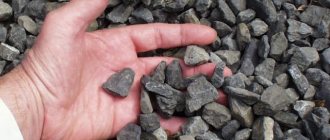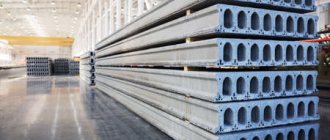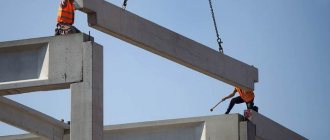Organizing a convenient road is important in construction of any scale. For the construction of access roads, the easiest way is to use reinforced concrete road slabs, the dimensions of which can be selected according to the conditions of use. We understand how reinforced concrete products are classified and how they are laid in certain cases.
Installation of road slabs Source demontazhnik.com.ua
Manufacturing, design and parameters
High-quality concrete products are manufactured in industrial conditions using the following technology:
- Preparation. The pouring mold is cleaned of concrete residues from the previous cycle. The inner surface of the metal mold is coated with lubricant. The lubricant layer reduces the adhesion of the concrete mixture and makes it easier to remove the finished product.
- Reinforcement. A frame (main and auxiliary reinforcement mesh) is installed in the mold. Caracas can be tensioned (assembled from pre-tensioned rods) or non-tensioned (made from wire or reinforcement). When the frame is formed, it is fixed to maintain the specified distances.
- Pouring concrete. At different enterprises, concrete is poured in two ways: on a stand (in small workshops) or on a conveyor line.
- Heat treatment. The prepared forms are placed in thermal chambers. Here the workpiece is treated with hot steam until the slabs gain 60% strength. The process takes 8-12 hours.
- Extraction. When the products have set, remove the fasteners. The slabs are removed, quality checked, and marked.
Metal molds for the production of reinforced concrete products Source aerodorstroy.ru
The characteristics of the slabs are influenced by the properties of the concrete mixtures used. To increase wear resistance and strength, mixtures with different water resistance and frost resistance are used. Reinforcement of different diameters, with different tensile strength values, and different grades of steel are also used. To form reinforced concrete products, predominantly corrugated reinforcement is chosen.
Concrete serves as a binding agent. The higher the grade of concrete, the stronger the structure, the better it will resist loads. Some types of slabs have a corrugated surface, which allows asphalt or other coating to stick on top. For ease of installation, the end sides of some plates are provided with hinges embedded in special recesses.
State standards require a basic classification according to parameters as follows:
- Products with dimensions 300x175 cm (length, width).
- Products with dimensions 350x275 cm
- For products with a length of 600 cm, the width varies: 175, 187, 350, 375 cm.
Mounting loops in reinforced concrete structures Source ubet39.ru
Intermediate dimensions are also possible. The finished product has the following parameters:
- The thickness of the road slab varies between 140-180 mm.
- The mass reaches 4-5 tons, part of it is reinforcement. For example, in a PDN-14 slab weighing 4105 kg, the concrete part accounts for 4032 kg, and the reinforcement accounts for approximately 73 kg. For the PDN-18 brand weighing 5284 kg, respectively, 5184 and approximately 100 kg.
Classification
The performance characteristics of slab construction mat are described in GOST 21924.0-84 (Reinforced concrete slabs for urban road surfaces). Products can be conveniently divided into the following categories:
- PDP (flat road slab). A universal and therefore in demand product; designed for frosts down to – 50°C. Suitable for the construction of temporary and permanent roads, can be reused. The material can withstand an average load: 10-30 tons (depending on the brand of concrete mixture).
- PDN (stressful road). The product has expanded capabilities: it is not afraid of frosts down to -55°C, thanks to reinforced reinforcement it behaves well on soft soils, and copes with increased dynamic loads. Suitable for use in areas with harsh winters.
Dimensions of road reinforced concrete products Source amazonaws.com
See also: Catalog of companies that specialize in designing and performing landscape work of any complexity
- PAG (airfield smooth). The most durable and massive (from 5 tons) products. They are divided into two types: with the help of PAG-14 they build roads for heavy vehicles, the PAG-18 nomenclature is intended for runways. Corrugated products can withstand frosts of at least -35°C and loads of up to 75 tons.
The marking includes alphabetic and numerical parts. The letter markings of road slabs indicate the shape and method of use; the gradation looks like this:
- P (or 1P, 2P). Standard shaped products.
- PB or PBB. Products with one or two combined sides.
- PT. The products are trapezoidal with slight corrugation.
- PSH. Hexagonal options. They may have different proportions and methods of combination, as evidenced by the abbreviations PShP and PShD.
The first number indicates the method of using reinforced concrete products for the road surface (whether it will be permanent or temporary); One means permanent coverage, two means temporary. Lastly, the dimensions of concrete road slabs are indicated. For each product its own parameters are indicated (in decimeters, rounded to the nearest whole number).
The canvas is designed for use under high loads Source folksland.net
About the pros and cons of technology
The use of reinforced concrete products in road construction is beneficial for the following reasons:
- Relatively small budget required for laying road slabs; nice price/quality ratio.
- Quality. The slab material is manufactured in a factory and has strictly regulated performance characteristics.
- Long lasting results. A road or platform made of road slabs, built in accordance with the technology, will last 30-40 years.
- Simple technology with high performance. Ready-made concrete products are stacked using a truck crane or other crane equipment. The speed of installation does not affect the quality of the coating.
- High performance characteristics. The road surface is durable, wear-resistant, resistant to dynamic loads and weather factors. In Russian conditions, the resistance of the road surface to a wide temperature range (from -50 to +55°C) is especially important.
- Reuse. The temporary road surface can be dismantled and reused (if the reinforced concrete products have not reached the end of their strength life).
Laying a slab in a roadbed Source sevparitet.ru
The connecting seams between the slabs are considered a significant drawback. If it is necessary for the surface to be perfectly flat, a layer of asphalt is placed on top, but this makes the project more expensive. On short roads, the seams are sealed with mortar.
No. 6. Features of transporting road slabs
Road slabs are heavy products that require special transportation conditions in order for them to arrive at the installation site safe and sound. All delivery problems are usually dealt with by manufacturing companies, but it does not hurt the buyer to know the general rules for the delivery of such cargo.
Precast concrete slabs are transported by trucks with an open body and a crane. To deliver heavy slabs or large quantities of products, long trucks are used. If it is necessary to transport slabs of non-standard large sizes, then planners, trucks with a large carrying capacity and an elongated body come to the rescue.
It is important that the seller, manufacturer or carrier installs and secures the slabs correctly. Otherwise, the slabs may shift while moving and become damaged. Loading and unloading are carried out smoothly and carefully, and a low speed is selected during delivery.
Permanent road installation technology
The construction of a road from reinforced concrete products looks simple, however, and there are subtleties that are significant for the result. In any project, the work ends with laying road slabs, but the technology differs somewhat depending on the type of road being constructed.
The peculiarity of installing a permanent road is that the procedure for preparing the soil base takes more time than installing the roadbed itself. It is the bottom layer that is responsible for the stability of the road and its future strength. Therefore, after marking the road surface, the base for road slabs is prepared in the following order:
- Alignment. The slabs need a flat surface, so they form a road trench by cutting off 25-30 cm of soil along the markings.
- Geotextiles are placed at the bottom; it will separate the layers and reinforce the entire structure. Additionally, the bottom of the trench will be protected from erosion.
Use of geotextiles in road construction Source bazagbi.ru
- A drainage layer is created: they are filled with crushed stone (gravel) and, higher up, with sand. The pillow is moistened with water and compacted: when finished, its thickness reaches 20-25 cm.
- Carry out the final leveling of the base using a level.
Precast concrete products are laid on the prepared base, the markings of which begin with two. The work is characterized by the following features:
- The correct installation of road slabs (evenness of laying) is controlled with a stretched cord.
- A team is hired to do the work; A crane is used to move the slabs. The qualifications of the crane operator will help to minimize damage to the slab material during the work.
- In addition to the crane operator, there are slingers who fix the slabs using the mounting loops. Precast concrete products are laid sequentially, according to the design, on a prepared base, and adjusted manually.
- It is important to fix the reinforced concrete products motionlessly. To do this, they are rigidly welded through mounting loops using metal rods. The remaining voids are filled with concrete.
Compacting the base with a vibrating tool Source avkproekt.ru
Technology for laying temporary road surface (on sand)
The technology involving the creation of a gravel-sand cushion is also found in private construction. With its help, driveways and parking lots are created in the backyard area. When installing, geotextiles are not abandoned: it prevents weeds from growing in the joints between the tiles.
Often, small-sized concrete slabs, rectangular or hexagonal in format, are chosen for arranging garden paths. The option is acceptable for a pedestrian path (or site) with a small expected load.
In this case, the laying of concrete slabs is carried out according to a simplified scheme, on a sand cushion; a layer of geotextile is also desirable. To secure the edges of the path, use a concrete curb.
The method is suitable if the road is a temporary solution, or its load will be low or non-periodic. For a temporary road, it is allowed to use used material, make a simplified (sand) cushion and not connect the slabs to each other.
A simplified approach reduces the cost of work by 2-3 times, without much difference in quality (only the expected service life is reduced).
Laying slabs for a local road Source demontazhnik.com.ua
PC panels
Rice. 4. Floor slabs
PC concrete slabs are most often used in construction. Areas of application: construction of multi-storey buildings, buildings and structures, pitched roofs of garages and sheds, installation of protective structures for heating mains. PCs are also used as a foundation for gazebos and fences.
Through voids of semicircular, round or oval shape are located along the entire length. PC is the basic version with support on 2 sides, PKT is supported on 3 sides, PKK - on 4.
The purpose of hollow-core slabs is to construct horizontal floors in multi-storey buildings, including commercial, residential and administrative ones. Utilities are placed in the voids.
The main advantages of hollow-core concrete slabs:
- Reduced weight compared to solid concrete products. The load on load-bearing walls is lower than when using slabs without voids, which is why PCs are in demand in multi-story construction.
- Soundproofing properties. Thanks to air pockets, the slabs reduce the level of noise coming from rooms located on the floor above or below.
- Thermal insulation characteristics. Air has low thermal conductivity, so heat is better retained in a room with hollow-core floors.
Products up to 4.2 m in length are reinforced with conventional mesh, and prestressed reinforcement is used to strengthen longer products. To strengthen the ends, vertical meshes are installed along the edges.
Briefly about the main thing
Road concrete slabs are a convenient, proven material if you need to quickly make a high-quality road or platform. Slab products are classified according to regulatory documents by purpose, as well as by size and shape. For the manufacture of reinforced concrete products, concrete of different grades is used; the reinforcing element is a steel mesh of rods with a corrugated surface.
The technology for constructing a permanent and temporary road is different. Paths and platforms in a suburban or summer cottage are built according to a simplified version, which ensures sufficient quality and at the same time reduces the budget.
PNO
Rice. 6. PNO plate
Lightweight PNO products are produced in accordance with GOST 9561 and the addition to the series 1.141-1, no. 39. The peculiarity of these concrete slabs is their reduced thickness, which is only 160 mm versus the standard 220 mm. The products are intended for the construction of buildings up to 3 floors high inclusive. Load-bearing capacity - from 300 to 800 kgf/m2.
Standard dimensions: length - 1600-6300 mm, width - 1000-1500 mm. The slab has through longitudinal voids, thanks to which it has increased noise and heat insulation characteristics and lower weight compared to solid products of similar dimensions. It is possible to cut the concrete slab across and at an angle.











